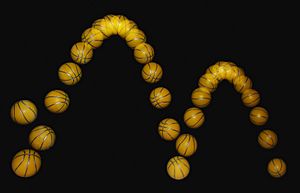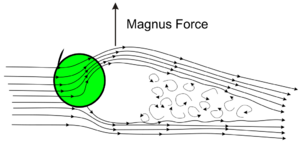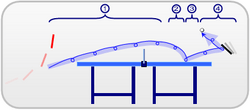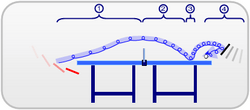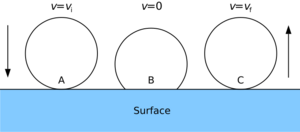Bouncing ball facts for kids
Have you ever wondered why a ball bounces the way it does? The physics of a bouncing ball is all about understanding how balls move and react when they hit something, like the ground or a wall. It's a great way to learn about how things move in physics classes. Even though it seems simple, figuring out exactly how a ball bounces can be quite tricky!
A ball's movement through the air is called projectile motion. Many things can affect this motion, like gravity, how much air resistance it faces, and even if it's spinning (the Magnus effect). When the ball hits a surface, how much it bounces is measured by something called the coefficient of restitution. This depends on what the ball is made of, what it hits, and how fast it's going. To make sports fair, many organizations set rules about how bouncy their balls can be. People have been playing with bouncy balls for thousands of years, like in the ancient Mesoamerican ball game.
Contents
How Forces Affect a Ball's Flight
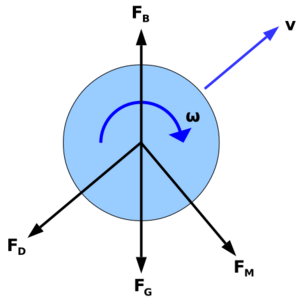
A bouncing ball moves through the air following the rules of projectile motion. Several forces act on a real ball as it flies:
- The gravitational force (FG) pulls it down.
- The drag force (FD) from air resistance slows it down.
- The Magnus force (FM) pushes it sideways if it's spinning.
- The buoyant force (FB) pushes it slightly upwards.
To understand a ball's motion, scientists use Newton's laws of motion. This helps them figure out how these forces make the ball speed up, move, and change its place over time.
Gravity's Pull on a Ball
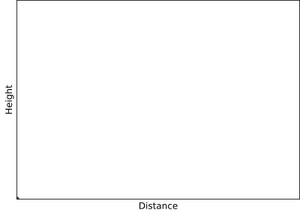
The force of gravity always pulls the ball downwards. This force depends on the ball's mass and the gravitational acceleration of Earth. On Earth, gravity pulls things down at about 9.8 meters per second squared (m/s²).
Often, we imagine a ball moving only because of gravity. In this perfect situation, the ball's total energy stays the same. If a ball is thrown at an angle, its movement can be split into two parts:
- Horizontal motion: It moves at a steady speed sideways.
- Vertical motion: It speeds up as it falls and slows down as it goes up, due to gravity.
These ideas help us predict how high a ball will go and how far it will travel. Lighter balls are affected more by other forces like air resistance because they don't have as much mass to resist those forces.
How Air Drag Slows a Ball
When a ball flies through the air, it pushes air out of the way. This creates a force called drag, which slows the ball down. The amount of drag depends on how fast the ball is moving, the air density, and the ball's shape and size.
For most sports balls, drag is a big deal. It makes the ball lose energy during its flight. This means the ball won't go as high or as far as it would in a vacuum. Strong winds can also push the ball off course. Athletes in sports like golf or baseball have to consider drag when they hit the ball.
The Magnus Effect and Ball Spin
When a ball spins as it flies, it creates a special force called the Magnus effect. This force pushes the ball sideways, perpendicular to its motion and spin.
- If a ball has backspin (spinning backward), the Magnus force pushes it upwards. This makes the ball stay in the air longer and go further.
- If a ball has topspin (spinning forward), the Magnus force pushes it downwards. This makes the ball drop faster.
The Magnus effect is super important in many sports. In tennis or volleyball, players use topspin or backspin to control where the ball goes. Golfers sometimes accidentally slice or hook the ball because of spin, but they also use spin to make their drives go further. Baseball pitchers use spin to throw curveballs that trick batters.
Sometimes, people try to illegally change a ball's surface to make it spin more or less. This is called Ball tampering and is against the rules in sports like cricket and baseball.
Buoyancy: Air's Gentle Lift
Any object in a fluid, like air or water, gets a small upward push called buoyancy. This force is equal to the weight of the air the ball pushes aside. For a ball, this force is usually very small compared to gravity or drag.
For example, a basketball feels a buoyant force that's about 1.5% of its weight. While small, this upward push can slightly increase how high and far the ball travels.
What Happens During Impact?
When a ball hits a surface, both the ball and the surface can squish a little, vibrate, and make sounds. The ball also loses some of its energy, turning it into sound and heat. Sometimes, hitting a surface can make the ball start spinning or change its spin.
We measure how much energy a ball loses during impact using the coefficient of restitution (COR). It's a number between 0 and 1:
- A COR of 0 means the ball doesn't bounce at all (like a ball of clay hitting the ground).
- A COR of 1 means the ball bounces perfectly, losing no energy (this is rare in real life).
If you drop a ball straight down, its COR tells you how high it will bounce compared to its starting height. For example, if a ball has a COR of 0.8, it will bounce to 80% of its original height. The energy lost during a bounce can be calculated using the COR.
Many things can affect a ball's COR:
- The type of surface it hits (like grass, concrete, or a net).
- What the ball is made of (like leather, rubber, or plastic).
- The air pressure inside the ball (if it's hollow).
- How much the ball is spinning when it hits.
- How fast the ball is moving when it hits.
Even the temperature can change how bouncy a ball is, because it can make the ball or surface softer or harder. Generally, a ball will squish more and lose more energy if it hits very fast, which lowers its COR.
Spin and How a Ball Bounces

When a spinning ball hits the ground, its spin and the angle it hits at can change how it bounces. Friction between the ball and the surface plays a big role.
Here's what can happen:
- Backspin: If a ball is spinning backward (backspin) and moving forward, friction will push it forward and upward. This can make the ball bounce higher than it started, or even bounce backward! Its spin will slow down.
- Topspin: If a ball is spinning forward (topspin) and moving forward, friction will try to slow its spin and speed up its forward motion.
* If it's spinning very fast, it might speed up forward but not bounce very high. * If it's moving very fast, its spin might increase, but its forward speed will decrease.
In sports like table tennis or racquetball, players use different spins (like sidespin) to make the ball change direction unexpectedly when it hits the table or wall. In cricket, bowlers use spin to make the ball curve and change direction off the pitch.
Bouncing Non-Spherical Balls
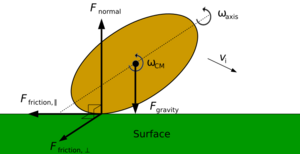
Oval-shaped balls, like those used in gridiron football or rugby football, bounce in a much less predictable way than round balls. When an oval ball hits the ground, how it's angled, how it's spinning, and how fast it's moving all affect its bounce.
The forces acting on the ball can make it bounce forward, backward, or even sideways. Sometimes, the ball can even gain forward speed after hitting the ground, which is very different from a round ball! This is because some of its spinning energy can turn into forward motion.
Bouncing Stacked Balls
A cool trick involves dropping two balls stacked on top of each other, like a tennis ball on a basketball. When they hit the ground, the tennis ball can bounce much, much higher than if it were dropped alone. It might even go higher than where it started!
This happens because the basketball transfers some of its energy to the tennis ball. The basketball doesn't bounce as high as it normally would, but it gives a big boost to the tennis ball. Imagine the basketball hitting the ground and bouncing up, then immediately hitting the tennis ball which is still falling. This double impact sends the tennis ball flying upwards with much more speed.
This idea helps scientists understand other complex things, like how supernovae explode or how spacecraft use gravitational slingshots to speed up around planets.
Rules for Sports Balls
Many sports organizations have rules about how bouncy their balls should be. This helps keep the game fair and consistent. Here are some examples:
- AFL: Sets the air pressure for their footballs.
- FIBA (Basketball): Requires basketballs to bounce between 1200 mm and 1400 mm when dropped from 1800 mm. This means the ball keeps about 73% to 81% of its energy.
- FIFA (Soccer): Sets the air pressure for soccer balls.
- FIVB (Volleyball): Sets the air pressure for indoor and beach volleyballs.
- ITF: Specifies how high a tennis ball must bounce when dropped from 100 inches (about 254 cm) onto a hard surface. Different types of balls have slightly different bounce requirements.
- ITTF: Requires a table tennis ball to bounce about 23 cm when dropped from 30 cm onto the table. This means it keeps about 88% of its energy.
- NBA: Sets the air pressure for basketballs.
- NFL: Sets the air pressure for American footballs.
- R&A/USGA (Golf): Directly limits how bouncy a golf ball can be when it hits a golf club.
Sometimes, sports rules don't directly say how bouncy a ball should be, but they describe how it must be made. For example, in baseball, changing how the ball was made (like adding a cork center) greatly affected how much it bounced and changed the game's history.
Images for kids


